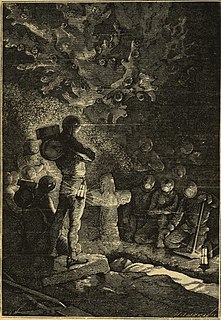Primary cremation and secondary cremation are terms in archaeology for describing burials of cremated bodies.
Archaeology, or archeology, is the study of human activity through the recovery and analysis of material culture. The archaeological record consists of artifacts, architecture, biofacts or ecofacts and cultural landscapes. Archaeology can be considered both a social science and a branch of the humanities. In North America archaeology is a sub-field of anthropology, while in Europe it is often viewed as either a discipline in its own right or a sub-field of other disciplines.

Burial or interment is the ritual act of placing a dead person or animal, sometimes with objects, into the ground. This is accomplished by excavating a pit or trench, placing the deceased and objects in it, and covering it over. Most would agree that humans have been burying their dead since shortly after the origin of the species. Burial is often seen as indicating respect for the dead. It has been used to prevent the odor of decay, to give family members closure and prevent them from witnessing the decomposition of their loved ones, and in many cultures it has been seen as a necessary step for the deceased to enter the afterlife or to give back to the cycle of life.

Cremation is the combustion, vaporization, and oxidation of cadavers to basic chemical compounds, such as gases, ashes and mineral fragments retaining the appearance of dry bone. Cremation may serve as a funeral or post-funeral rite as an alternative to the interment of an intact dead body in a coffin or casket. Cremated remains, which do not constitute a health risk, may be buried or interred in memorial sites or cemeteries, or they may be retained by relatives and dispersed in various ways. Cremation is an alternative in place of burial or other forms of disposal in funeral practices. Some families prefer to have the deceased present at the funeral with cremation to follow; others prefer that the cremation occur prior to the funeral or memorial service.
Primary cremation refers to burials where the body is burned "on the spot", in the grave. A secondary cremation is the burning of the body in one spot and then burying the remains and grave goods elsewhere. Secondary cremation may also more specifically refer to a cremation where the body is burned on a pyre, after which the bones are collected from the ashes and buried elsewhere (Sprague 2005:138). A famous account of such a burial is that of Homer's Iliad , describing the funeral of Patroclus.

A pyre, also known as a funeral pyre, is a structure, usually made of wood, for burning a body as part of a funeral rite or execution. As a form of cremation, a body is placed upon or under the pyre, which is then set on fire.

Homer is the legendary author of the Iliad and the Odyssey, two epic poems that are the central works of ancient Greek literature. The Iliad is set during the Trojan War, the ten-year siege of the city of Troy by a coalition of Greek kingdoms. It focuses on a quarrel between King Agamemnon and the warrior Achilles lasting a few weeks during the last year of the war. The Odyssey focuses on the journey home of Odysseus, king of Ithaca, around 20 years after the fall of Troy. Many accounts of Homer's life circulated in classical antiquity, the most widespread being that he was a blind bard from Ionia, a region of central coastal Anatolia in present-day Turkey. Modern scholars consider these accounts legendary.

The Iliad is an ancient Greek epic poem in dactylic hexameter, traditionally attributed to Homer. Set during the Trojan War, the ten-year siege of the city of Troy (Ilium) by a coalition of Greek states, it tells of the battles and events during the weeks of a quarrel between King Agamemnon and the warrior Achilles.











